
Understanding Aquatic Weed Varieties
What if understanding aquatic weeds could be the key to restoring our waterways? As we dive deeper into the significance of aquatic ecosystems, recognizing the types of aquatic weeds becomes essential for effective management and preservation.
What You Will Learn
- Differentiating between native and invasive aquatic weeds is crucial for effective ecosystem management.
- Aquatic weeds contribute significantly to habitat provision, water quality improvement, and food sources within ecosystems.
- Classifying aquatic weeds by their growth habit (emergent, submersed, floating, and algae) aids in targeted management strategies.
- Climate change is reshaping aquatic plant distributions, complicating management efforts and necessitating proactive approaches.
Aquatic Weed Classification & Climate Change Impact
Understanding the types of aquatic weeds and how climate change influences their distribution is crucial for effective waterway management. Below, we categorize weeds by growth habit and highlight the impacts of a warming climate.
Classification by
Growth Habit
Growth habit dictates identification & management strategies.
Climate Change
Impacts
Warming climates shift distribution and intensify invasive species challenges.
Understanding Aquatic Weed Types: The Importance of Classification
As we explore the fascinating world of aquatic ecosystems, one of the first steps is understanding the different types of aquatic weeds. Knowledge of these plants not only helps in managing them effectively but also informs us about their ecological roles. Did you know that recognizing the various species of aquatic weeds can significantly impact the health of our waterways? By understanding their classifications, we can take informed actions towards maintaining balanced water habitats.
At Aquatic Weed Solutions, I emphasize the importance of this knowledge in my educational outreach. Being able to identify aquatic plants can empower landowners and managers to address invasive species before they take hold, preserving the integrity of aquatic environments.
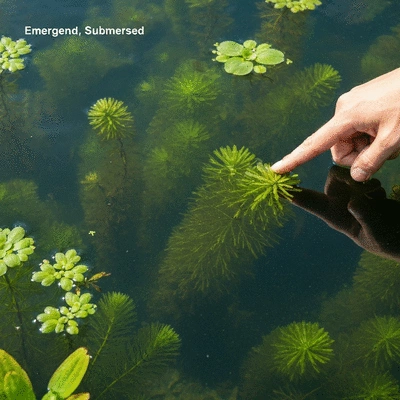
Why Knowledge of Aquatic Plants Matters for Ecosystems
Understanding aquatic plants goes beyond mere identification; it helps us grasp their ecological functions. Aquatic weeds can provide habitats for various species, improve water quality, and contribute to the overall health of an ecosystem. However, the introduction of invasive species can disrupt these benefits, leading to challenges that require our collective attention.
- Habitat Provision: Many aquatic plants serve as critical habitats for fish and other wildlife.
- Water Quality Improvement: They play a role in filtering pollutants and stabilizing sediments.
- Food Source: Aquatic plants are a food source for many aquatic organisms, contributing to the food web.
The more we know about these plants, the better equipped we are to manage our waterway ecosystems effectively. This understanding fosters a proactive approach, allowing us to maintain ecological balance and ensure that our waterways thrive.
Defining Aquatic Weeds: Native vs. Invasive Species
It’s crucial to differentiate between native and invasive aquatic weeds. Native species are plants that have evolved in a particular region and play essential roles in their ecosystems. In contrast, invasive species are often non-native and can cause harm by outcompeting local flora for resources.
- Native Species: These plants are adapted to local conditions and help maintain ecological stability.
- Invasive Species: These plants can disrupt the balance, leading to reduced biodiversity and altered habitats.
By recognizing the differences between these types of aquatic weeds, we can focus our management strategies on protecting native species while controlling the spread of invasive ones. My goal at Aquatic Weed Solutions is to empower individuals with the knowledge to identify and manage these plants effectively, ensuring healthier ecosystems for future generations.
Classifying Aquatic Weeds by Growth Habit
When we classify aquatic weeds, growth habit is an essential factor to consider. Understanding how different species grow helps in their identification and management strategies. Aquatic weeds can be grouped into several categories based on their growth forms: emergent, submersed, floating, and algae.
- Emergent Plants: These plants grow above the water's surface.
- Submersed Plants: These species are fully submerged in water.
- Floating Plants: These plants float on the water's surface.
- Algae: These can vary from microscopic to large forms.
By understanding these classifications, we can create targeted management plans that address the specific challenges each growth habit presents. In the following sections, I’ll delve into each category, highlighting key species and their ecological roles.
Emergent Plants: Characteristics and Key Species
Emergent plants are often the first line of vegetation found along the edges of lakes and rivers. They thrive in shallow waters and provide essential habitat for wildlife. Understanding their characteristics helps in identifying and managing them effectively.
Common Examples: Cattails and Bulrushes
- Cattails: These tall, reed-like plants are common in wetlands and provide habitat for birds.
- Bulrushes: Known for their triangular stems, these plants help stabilize shorelines and improve water quality.
Recognizing these emergent species can help landowners and ecologists develop strategies to enhance native populations while controlling invasive plants that threaten these vital ecosystems. Remember, maintaining native emergent plants is not just about aesthetics; it’s about creating a thriving habitat that benefits all aquatic life.
Submersed Plants: Identification and Ecological Roles
Submersed plants are fully underwater and play a crucial role in aquatic ecosystems. They provide oxygen, serve as food sources, and offer shelter for fish and invertebrates. Knowing how to identify these plants can help in managing aquatic environments effectively.
Focus on Watermilfoil, Hydrilla, and Other Key Species
- Watermilfoil: This plant can rapidly reproduce and, if left unchecked, can choke waterways.
- Hydrilla: Known for its aggressive growth, hydrilla can drastically alter aquatic habitats.
- Najas (Curlyleaf Pondweed): A native option that can thrive in various conditions, providing ecological benefits.
Understanding these submersed plants allows us to recognize which species contribute positively to our ecosystems and which ones may need management strategies to prevent them from dominating and harming the environment.
Floating Plants: Types and Their Impact on Water Bodies
Floating plants can be beautiful additions to aquatic environments, but some can also pose significant challenges. They float on the water's surface and can impact light penetration and oxygen levels in the water.
Understanding Duckweed, Water Lettuce, and Water Hyacinth
- Duckweed: A small floating plant that can quickly cover water surfaces, potentially blocking sunlight.
- Water Lettuce: This plant resembles a head of lettuce and can also lead to overgrowth issues.
- Water Hyacinth: An invasive species that can double its biomass in just a few days, causing severe ecological disruption.
Recognizing these floating plants is vital for managing their growth and understanding their impact on aquatic ecosystems. At Aquatic Weed Solutions, I advocate for a balanced approach that respects the beauty of these plants while addressing their potential threats.
Algae Types: Filamentous vs. Macroalgae and Their Ecological Roles
Algae are often misunderstood components of aquatic ecosystems. While they can be beneficial, excessive growth can lead to issues like algal blooms that deplete oxygen levels in the water. Identifying the type of algae present can inform management strategies.
The Benefits and Challenges of Algal Growth
- Filamentous Algae: These long strands can create dense mats that disrupt water flow and reduce oxygen levels.
- Macroalgae: Larger algae can provide habitat for some species but can also outcompete native plants when overgrown.
Understanding both filamentous and macroalgae allows us to appreciate their ecological roles while also being proactive about managing their growth in our waterways. Effective management is about striking a balance between harnessing their benefits and mitigating their challenges.
Frequently Asked Questions About Aquatic Weeds
Why is it important to differentiate between native and invasive aquatic weeds?
Differentiating between native and invasive aquatic weeds is crucial because native species support local ecosystems, providing habitat and improving water quality, while invasive species can outcompete native flora, disrupt ecological balance, and harm biodiversity. Effective management targets invasive species while protecting native ones.
How do aquatic weeds contribute to the ecosystem?
Aquatic weeds, particularly native species, contribute significantly by providing critical habitats for fish and wildlife, improving water quality through filtration and sediment stabilization, and serving as a food source for many aquatic organisms, thus supporting the food web.
What are the main classifications of aquatic weeds based on growth habit?
Aquatic weeds are primarily classified into four growth habits: emergent plants (grow above water), submersed plants (fully submerged), floating plants (float on water surface), and algae (microscopic to macroscopic forms). This classification helps in developing targeted management strategies.
How does climate change impact aquatic weed distribution and management?
Climate change, through rising temperatures and altered precipitation, can create favorable conditions for invasive aquatic plant species to thrive and shift their distribution. This increases competition with native species, alters ecosystems, and necessitates more resources and proactive monitoring for effective management. For example, warmer waters can intensify the proliferation of species like water hyacinth, as discussed by experts in EurekAlert!.
What are some common invasive aquatic weed species mentioned in the article?
The article mentions Watermilfoil, Hydrilla, and Water Hyacinth as common examples of invasive aquatic weed species that can cause significant ecological disruption if left unchecked. Projects like the UC ANR Delta Region Areawide Aquatic Weed Project are actively working to manage these threats.
We Want to Hear From You!
What challenges have you faced in managing aquatic weeds in your area? Share your experiences and thoughts below:
Addressing Climate Change Impact on Aquatic Weeds
As climate change continues to reshape our environments, understanding its effects on aquatic weeds is crucial for effective management. Rising temperatures, changing precipitation patterns, and increased nutrient runoff can create ideal conditions for certain invasive aquatic plant species to thrive. This not only disrupts local ecosystems but also complicates our efforts to maintain healthy waterways.
It’s essential to recognize that climate change doesn't just impact existing weed populations; it also alters the distribution patterns of aquatic plants. For instance, as the climate warms, we may see shifts in where species like water hyacinth proliferate, potentially moving into regions previously unaffected. Being aware of these changes can help us adapt our management strategies effectively.
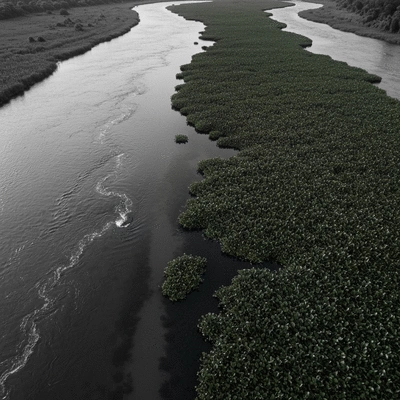
The Future of Aquatic Plant Distribution and Management Challenges
Looking ahead, the anticipated changes in aquatic plant distribution present significant management challenges. Here are some key considerations:
- Increased Competition: Native species may struggle to compete with invasive plants that thrive in warmer conditions.
- Altered Ecosystems: Changes in plant distributions can affect food webs, habitat availability, and biodiversity.
- Resource Allocation: Management efforts may require more resources as invasive species spread and become more resilient.
Understanding these dynamics allows us to refine our approach to managing aquatic ecosystems. At Aquatic Weed Solutions, we emphasize the importance of proactive monitoring and flexible management plans to address these changes head-on.
Impact of Climate Change on Water Hyacinth and Other Invasive Species
Water hyacinth, often labeled a notorious invasive species, exemplifies how climate change can amplify management challenges. With warmer waters and nutrient runoff from storms, this plant can become even more pervasive, creating dense mats that choke waterways. The implications for aquatic life and water quality are profound!
To combat this escalating issue, we must stay informed and consider innovative management techniques. Here are some strategies to address the challenges posed by water hyacinth and other invasive species:
- Regular Monitoring: Keep an eye on changes in plant populations and distribution.
- Targeted Control Measures: Utilize a combination of physical, chemical, and biological methods tailored to specific conditions.
- Collaboration: Work with local conservation groups and experts to share insights and resources.
With a proactive approach, we can mitigate the impact of climate change on these invasive plants and safeguard our water ecosystems.
Recap of Key Points
Here is a quick recap of the important points discussed in the article:
- Importance of Classification: Understanding aquatic weeds is crucial for effective management and ecological balance.
- Native vs. Invasive Species: Differentiating between native and invasive aquatic plants is essential to protect local ecosystems.
- Growth Habits: Classifying aquatic weeds by their growth forms (emergent, submersed, floating, algae) aids in targeted management strategies.
- Impact of Climate Change: Climate change is altering the distribution of aquatic plants, increasing the prevalence of invasive species.
- Proactive Management: Regular monitoring, targeted control measures, and collaboration with experts can help mitigate the impact of invasive species.

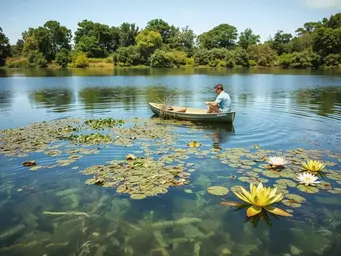

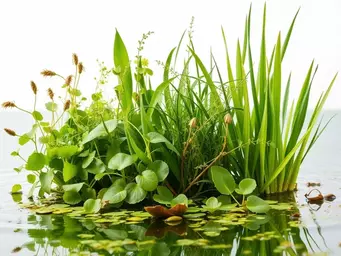
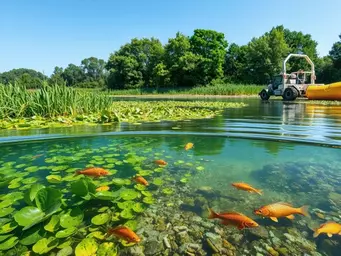
Managing Aquatic Weeds Effectively
Impact of Aquatic Weeds on Recreation
Understanding Aquatic Weed Varieties
Integrated Aquatic Weed Management Methods
Integrated Approaches to Aquatic Weeds